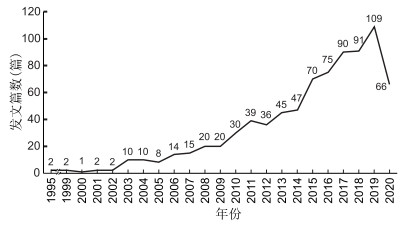A co-word clustering analysis based on the current state of research on kinesiophobia
-
摘要:
目的 通过共词聚类分析和书目共现系统综合分析国内外关于恐动症的研究现状及主流方向,以便为解决恐动症患者带来的临床问题提供借鉴作用。 方法 采用题目与摘要检索、主题词检索、关键词检索和全文检索相结合的方法,以Pubmed文献库为数据源检索从1995年1月—2020年2月的恐动症相关文献,运用书目信息数据库挖掘系统(BICOMB)和图形聚类工具(gCLUTO)软件提取文献主题词及副主题词、文献年代、期刊分布、国家地区分布等关键字段并进行数据处理,从文献增长规律、年度分布、国家分布、主题词等对其进行共词聚类分析。 结果 共检索到恐动症相关文献804篇,显示恐动症研究人群范围广,涉及各年龄段;恐动症年发文量总体呈小幅度上升趋势,部分年份缺乏连续性,各国家地区间发表篇数差距较大;研究工具及干预方法相对单一,研究内容相对狭窄,且学科方向较为局限。 结论 经恐动症相关高频主题词导入gCLUTO软件进行聚类分析得出,恐动症的研究领域较为集中,学科主题具有突出性,多受益于骨关节外科疾病如膝关节置换术后、慢性腰背痛等。通过共词聚类分析把握了当前恐动症研究的主流方向和热点问题,临床可结合国内文化及发展现状制定符合恐动症患者的系列干预措施,以便为解决恐动症患者带来的临床问题提供帮助,并为今后开展更深入的临床探索提供参考。 Abstract:Objective To comprehensively analyze the current status and mainstream direction of research on kinesiophobia by cluster analysis and bibliographic cooccurrence system, so as to provide a reference for solving clinical problems brought about by patients with kinesiophobia. Methods The topic and abstract retrieval, subject word retrieval, keyword retrieval and full text retrieval were combined. The Pubmed literature database was used as the data source to retrieve the documents related to kinesiophobia from January 1995 to February 2020, and the bibliographic information was used. The database mining system (BICOMB) and graphic clustering tool (gCLUTO) software extracted key fields such as document subject headings and subtopics, document years, periodical distribution, national and regional distribution, and perform data processing. The co-word cluster analysis was carried out from the aspects of literature growth law, annual distribution, country distribution and subject words. Results A total of 804 articles related to kinesiophobia were retrieved, showing that the population of kinesiophobia research was wide and involved in all ages. The annual number of articles published in kinesiophobia showed a slight upward trend, and some years lacked continuity, published between countries and regions. There was a large gap between the numbers of articles. The research tools and intervention methods were relatively single, the research content was relatively narrow, and the discipline direction was relatively limited. Conclusion Cluster analysis of high-frequency subject words related to acrophobia by introducing gCLUTO software shows that the research field of phobia is relatively concentrated and the subject theme is prominent. Most of them benefit from bone and joint surgical diseases such as knee replacement, chronic Low back pain, etc. Through cluster analysis, we have grasped the mainstream direction and hot issues of current research on phobia, the clinical can combine the domestic culture and development status to formulate a series of intervention measures in line with patients with kinesiophobia, in order to solve the clinical problems caused by patients with acrophobia, and provide a reference for further in-depth clinical exploration in the future. -
Key words:
- Kinesiophobia /
- Research status /
- Bibliometrics /
- Cluster analysis
-
表 1 发表恐动症相关文献数量前10位的国家
序号 国家名称 出现频率(次) 百分比(%) 累计百分比(%) 1 United States(美国) 328 40.80 40.80 2 England(英国) 223 27.74 68.53 3 Germany(德国) 61 7.59 76.12 4 Netherlands(荷兰) 53 6.59 82.71 5 Sweden(瑞典) 24 2.99 85.60 6 Scotland(苏格兰) 18 2.24 87.94 7 Italy(意大利) 11 1.37 89.30 8 Japan(日本) 11 1.37 90.67 9 Brazil(巴西) 10 1.24 91.92 10 New Zealand(新西兰) 10 1.24 93.16 表 2 发表恐动症相关文献数量前10位的期刊
序号 期刊名称 文献数量
(篇)百分比
(%)累计百分比
(%)1 BMC Musculoskeletal Disorders 32 3.98 3.98 2 Spine 29 3.61 7.59 3 Pain 25 3.11 10.70 4 The Clinical Journal of Pain 23 2.86 13.56 5 Archives of Physical Medicine And Rehabilitation 22 2.74 16.29 6 European Journal of Pain 22 2.74 19.03 7 Journal of Rehabilitation Medicine 21 2.61 21.64 8 Physical Therapy 20 2.49 24.13 9 European Spine Journal 18 2.24 26.37 10 Knee Surgery 17 2.11 28.48 表 3 恐动症相关文献前20高频主题词及副主题词
序号 主题词+副主题词 频次
(次)百分比
(%)累计百分比
(%)1 Hunmans(人类) 633 5.60 5.60 2 Female(女性) 566 5.01 10.61 3 Male(男性) 643 4.81 15.42 4 Adult(成年人) 484 4.28 19.70 5 Midle Aged(中年) 455 4.03 23.73 6 Surveys and Questionnaires(问卷调查) 233 2.06 25.79 7 Pain measurement(疼痛测量) 219 1.94 27.73 8 Aged(年老的) 209 1.85 29.58 9 Disability Evaluation(伤残评定) 188 1.66 31.25 10 Young Adult(年轻人) 172 1.52 32.77 11 Adolesoent(青春期) 136 1.20 33.97 12 Cross-Sectional studies(横断面研究) 129 1.14 35.12 13 Low Back pain/ psychology(下腰背痛/心理) 125 1.11 36.22 14 Treatment Outcome(治疗效果) 123 1.09 37.31 15 Fear/psychology(害怕/心理) 118 1.04 38.36 16 Fear(害怕) 107 0.95 39.30 17 Reproducibility of Results(结果重现) 96 0.85 40.15 18 Chronic Pain/Psycholigy(慢性疼痛/心理) 82 0.73 40.88 19 Chronic Disease(慢性疾病) 80 0.71 41.59 20 Quality of life(生活质量) 77 0.68 42.27 -
[1] LUQUE-SUAREZ A, MARTINEZ-CALDERON J, FALLA D. Role of kinesiophobia on pain, disability and quality of life in people suffering from chronic musculoskeletal pain: A systematic review[J]. Br J Sports Med, 2019, 53(9): 554-559. doi: 10.1136/bjsports-2017-098673 [2] KORI S H, MILLER R P, TODD DD L. Kinesiophobia: A new view of chronic pain behavior[J]. Pain Manag, 1990, 3: 35-43. http://ci.nii.ac.jp/naid/10027244987 [3] 孟浅. 躯体感觉皮层神经环路调控疼痛伴焦虑样行为的研究[D]. 合肥: 中国科学技术大学, 2019. [4] WILLIAMS A C C, CRAIG K D. Updating the definition of pain[J]. 2016, 157(11): 2420-2423. [5] SCHOPFLOCHER D, TAENZER P, JOVEY R. The prevalence of chronic pain in Canada[J]. Pain Res Manag, 2016, 16(6): 445-447. http://www.ncbi.nlm.nih.gov/pmc/articles/PMC3298051/pdf/prm16445.pdf [6] ISHAK N A, ZAHARI Z, JUSTINE M. Kinesiophobia, pain, muscle functions, and functional performances among older persons with low back pain[J]. Pain Res Treat, 2017, 1: 1-10. http://www.ncbi.nlm.nih.gov/pmc/articles/PMC5467352/pdf/PRT2017-3489617.pdf [7] LETHEM J, SLADE P D, TROUP J D, et al. Outline of a Fear-Avoidance Model of exaggerated pain perception--I[J]. Behav Res Ther, 1983, 21(4): 401-408. doi: 10.1016/0005-7967(83)90009-8 [8] LARSSON C, HANSSON E E, SUNDQUIST K, et al. Kinesiophobia and its relation to pain characteristics and cognitive affective variables in older adults with chronic pain[J]. BMC Geriatr, 2016, 16(1): 1-7. doi: 10.1186/s12877-015-0167-0 [9] DEMIRBÜKEN Í, ÖZGÜL B, KURU ÇOLAK T, et al. Kinesiophobia in relation to physical activity in chronic neck pain[J]. J Back Musculoskelet Rehabil, 2016, 29(1): 41-47. doi: 10.3233/BMR-150594 [10] MISTERSKA E, JANKOWSKI R, GŁOWACKI J, et al. Kinesiophobia in Pre-operative patients with cervical discopathy and coexisting degenerative changes in relation to pain-related variables, psychological state and sports activity[J]. Med Sci Monit, 2015, 21: 181-194. doi: 10.12659/MSM.891045 [11] ROVNER G S, SUNNERHAGEN K S, BJÖRKDAHL A, et al. Chronic pain and sex-differences; women accept and move, while men feel[J]. PLoS One, 2017, 12(4): e0175737. doi: 10.1371/journal.pone.0175737 [12] RACINE M, SOLÉ E, SÁNCHEZ-RODRÍGUEZ E, et al. An evaluation of sex differences in patients with chronic pain undergoing an interdisciplinary pain treatment program[J]. Pain Pract, 2020, 20(1): 62-74. doi: 10.1111/papr.12827 [13] YILMAZ YELVAR G D, ÇIRAK Y, DALKILINÇ M, et al. Is physiotherapy integrated virtual walking effective on pain, function, and kinesiophobia in patients with non-specific low-back pain? Randomised controlled trial[J]. Eur Spine J, 2017, 26(2): 538-545. doi: 10.1007/s00586-016-4892-7 [14] ULUĜ N, YAKUT Y, ALEMDAROĜLUÍ, et al. Comparison of pain, kinesiophobia and quality of life in patients with low back and neck pain[J]. J Phys Ther Sci, 2016, 28(2): 665-670. doi: 10.1589/jpts.28.665 [15] KUENZE C, CADMUS-BERTRAM L, PFIEFFER K, et al. Relationship between physical activity and clinical outcomes after ACL reconstruction[J]. Journal of sport rehabilitation, 2019, 28(2): 180-187. doi: 10.1123/jsr.2017-0186 [16] CORONADO R A, BIRD M L, VAN HOY E E, et al. Do psychosocial interventions improve rehabilitation outcomes after anterior cruciate ligament reconstruction?A systematic review[J]. Clin Rehabil, 2017, 11(6): 528-534. http://www.researchgate.net/profile/Rogelio_Coronado/publication/319278935_Do_psychosocial_interventions_improve_rehabilitation_outcomes_after_anterior_cruciate_ligament_reconstruction_A_systematic_review/links/59a59f460f7e9b41b786c817/Do-psychosocial-interventions-improve-rehabilitation-outcomes-after-anterior-cruciate-ligament-reconstruction-A-systematic-review.pdf [17] BCK M, CIDER S, HERLITZ J, et al. Kinesiophobia mediates the influences on attendance at exercise-based cardiac rehabilitation in patients with coronary artery disease[J]. Physiother Theory Pract, 2016, 32(8): 1-10. http://www.onacademic.com/detail/journal_1000039661449910_994d.html [18] FILARDO G, ROFFI A, MERLI G, et al. Patient kinesiophobia affects both recovery time and final outcome after total knee arthroplasty[J]. Knee Surg Sports Traumatol Arthrosc, 2016, 24(10): 1-7. [19] OSUMI M, SUMITANI M, OTAKE Y, et al. Kinesiophobia modulates lumbar movements in people with chronic low back pain: A kinematic analysis of lumbar bending and returning movement[J]. Eur Spine J, 2019, 28(7): 1572-1578. doi: 10.1007/s00586-019-06010-4 [20] 蔡立柏, 刘延锦, 赵辉, 等. 认知行为干预降低全膝关节置换后恐动症[J]. 中国组织工程研究, 2017, 21(23): 3658-3663. doi: 10.3969/j.issn.2095-4344.2017.23.009 [21] 宋莹莹, 张岚, 梁瑛琳, 等. 慢性下腰痛患者恐动症的研究进展[J]. 护理管理杂志, 2018, 18(8): 572-575. doi: 10.3969/j.issn.1671-315x.2018.08.009 [22] KORI S H, MILLER R P, TROUP J D, et al. Kinesiophobia: a new view of chronic pain behaviour[J]. Pain Manag, 1990, 3: 35-43. http://ci.nii.ac.jp/naid/10027244987 [23] 胡文. 简体中文版TSK和FABQ量表的文化调适及其在退行性腰腿痛中的应用研究[D]. 上海: 第二军医大学, 2012. [24] 刘延锦, 蔡立柏, 徐秋露, 等. 慢性疼痛患者恐动症的研究进展[J]. 中华护理杂志, 2017, 52(2): 234-239. doi: 10.3761/j.issn.0254-1769.2017.02.025 -





 下载:
下载:



